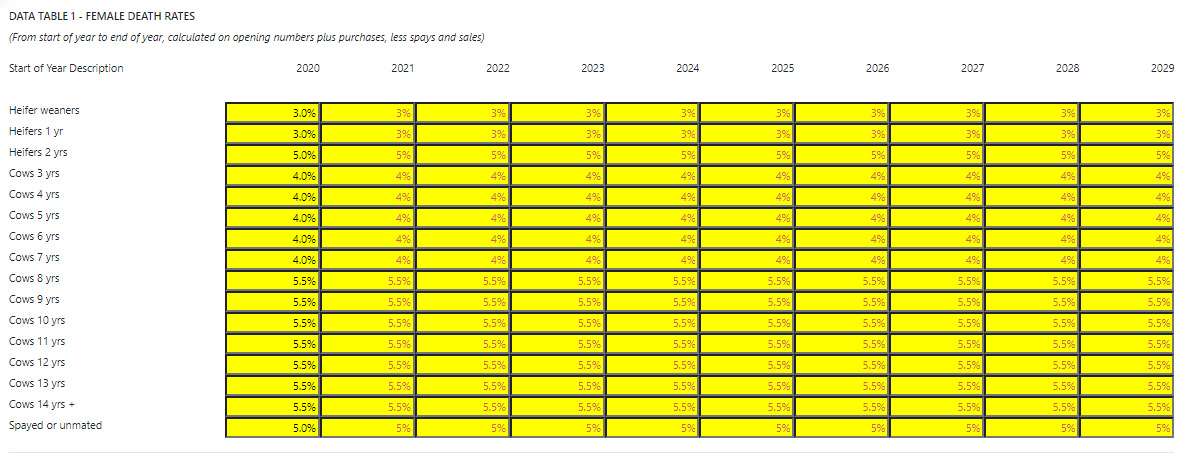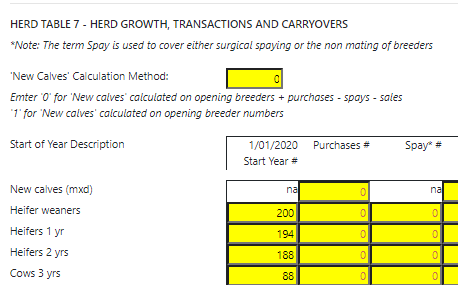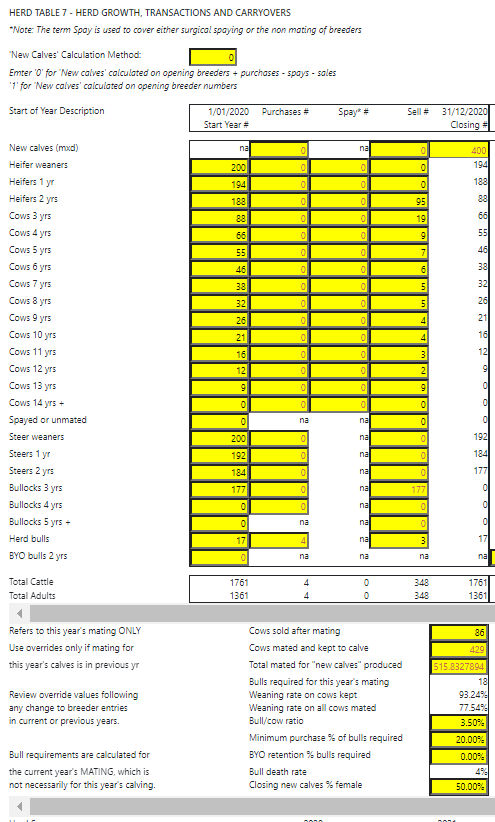Difference between revisions of "Dynama+ Dynama"
| Line 47: | Line 47: | ||
[[file:Herd Table 7.PNG|frame|center|The first year of Herd Table 7 of the Dynama worksheet from the example file.]] | [[file:Herd Table 7.PNG|frame|center|The first year of Herd Table 7 of the Dynama worksheet from the example file.]] | ||
| + | |||
| + | The number entered for Cows sold or spayed after mating is calculated by adding up the total number of females sold and taking away the sales number for one year old heifers as they were not mated and taking away the number for ten year old cows as they were also culled and not mated. | ||
| + | |||
| + | If herd data is imported from a [[Breedcowp+]] file, the number of cows sold after mating is automatically transferred to the first year of HERD TABLE 7. | ||
| + | |||
| + | Where the '''Import Autosales''' option is used to set up a sales and culling strategy across all years, the numbers of stock sold out of HERD TABLE 7 are based on the percentage values entered in the AutoSales table located to the far right of Table 7 in the Dynama worksheet. They are rounded to whole numbers. | ||
| + | |||
| + | Quite often when building a livestock schedule for a northern Australian breeding property, the numbers in each age group of male cattle and heifers on hand will be known but the age breakup for the breeding herd is unlikely to be accurately known. The best estimate of the split up of the breeding herd into age groups can be used as a starting point and varied later if necessary. Modelling the herd in Breedcow+ first and then transferring the values to Dynama+ - as has been done in the examples provided - will also provide an approximate breakup of the female herd into age groups that can then be adjusted where necessary. | ||
| + | |||
| + | Purchases in extensive northern Australian breeding herds will most commonly be bulls but other purchased livestock need to be identified and added to the relevant classes in Table 7 of the Dynama worksheet where necessary. They are entered in the purchases column of Table 7 in the year in which they are purchased. | ||
| + | |||
| + | Spaying can be surgical or it can mean keeping surplus cows separated from bulls. Cows shown as spayed or surplus in Table 7 will transfer out of their age groups into the spayed and surplus cow group. | ||
| + | For all fourteen year old cows and all five year old bullocks, formulas are set to automatically sell 100 percent of the number on hand at the start of the year. | ||
| + | |||
| + | Deaths are calculated in Table 7 on the opening numbers plus purchases less spays and sales. Spayed cow deaths in Table 7 are based on the opening number shown plus new spays minus sales. This assumes that sales occur early in the year. If some deaths are expected before sales, these may be factored in as negative entries in the Purchases column (with purchase price set to zero). The use of this “dirty” approach to calculating deaths should be noted on the Memo and any printouts should be corrected by hand with Deaths written over the top of Purchases. | ||
| + | |||
| + | ===AutoSales and AutoSpay=== | ||
Revision as of 05:39, 18 August 2020
Step 5 Complete the Dynama worksheet
The Dynama worksheet automatically takes values from the Dynama+ AECalc, Prices and Huscosts worksheets and combines them with data about births, losses, sales and purchases to build a ten year sequence of livestock schedules.
A livestock schedule (Dynama HERD TABLE 7) provides a snapshot of the structure and productivity of a cattle herd for up to a decade.
Once the performance of the cattle business has been identified in the livestock schedule, the Dynama worksheet connects its cattle trading outcomes to cost, asset and loans input to project cash flow, net income, debt and net worth.
Data Tables 1 to 6 - Deaths, Calving and Prices
The first four data tables in the Dynama worksheet only require entries for the first year if values are expected to remain the same over time. Year one are normal data entry cells (black text). Years two to ten are automatically generated (red-brown text) and allow new entries to be over typed. These formulas copy the initial values to the second and subsequent years in each table but may be overridden with value entries if later years are expected to have different values to the first year.

Re Data Table 3 – Weaning Rates: The weaning rate on "Cows mated 1 year" is based on the number of calves counted as weaned from "Heifers 1 year" as per the start of year description. Actual mating for those weaners may have been early in the current budget year, or in the previous budget year. Weaning rate for each age group of breeders is multiplied by eligible breeders in that group to determine "new calves" produced for the budget year.
Purchase prices shown in Table 4 of the Dynama worksheet should be entered so that they include (on a per head basis) all of the costs associated with purchasing the cattle unless such costs are not separable from the general property costs that will be entered later in the worksheet as part of fixed or overhead costs.
Data tables 5A and 6A are female and male sale prices that are taken directly from the Prices worksheet. Any desired changes to the values shown in these tables are best made in the Prices worksheet. Tables 5B and 6B (to the right of Tables 5A and 6A), are opening inventory values. Closing inventory values are taken off the opening values of the next year. Prices for “new calves” are to set sale prices only. “New calves” will have their closing values set off the opening values for heifer and steer weaners for the following year.
As the role of inventory values is to provide an estimate of the asset value of the overall herd, not just the sale cattle, inventory values can be altered if the sale prices are not an accurate representation of overall group values. These values are used to determine herd value and to calculate net income. To change an inventory value in Table 5B or 6B, override the formula with the desired value.
Inventory values of bulls almost certainly should be changed to reflect the paddock value of the total group of cattle, not just the sale value or purchase price. The inventory value for bulls should be somewhere between the cull price and the average purchase price.
Herd Table 7 - Herd Growth, Transactions and Carryovers
Table 7 is the livestock schedule that underpins the Dynama+ program. It takes the opening number for each class of cattle for the year, adds purchases, deducts sales, transfers spays out of the breeder groups then calculates deaths, new calves, and closing numbers.
Required entries to complete the livestock schedule for year one include:
- opening numbers for each class of livestock (at the beginning of year one)
- purchases
- spaying, and
- sales
The closing numbers from year one become the opening numbers for the next age group the following year. The year one closing numbers of new calves is divided between weaner heifers and steer weaners in the opening numbers of year two.
The number of new calves can be calculated either from the opening number of breeders plus purchases less females spayed or set aside and sales or from just the opening number of breeders.
The closing number of new calves equals calves produced by the breeder herd plus calves purchased minus calves sold. This calculation may be overridden with a numeric entry if actual numbers are being entered in the budget in place of the calculated figures.
The livestock schedule shown in Table 7 allows the female herd to be split up into two age groups for heifers (one and two year old heifers) and twelve age groups for older breeding females (years three to thirteen and then all females fourteen years and older in age).
The number entered for Cows sold or spayed after mating is calculated by adding up the total number of females sold and taking away the sales number for one year old heifers as they were not mated and taking away the number for ten year old cows as they were also culled and not mated.
If herd data is imported from a Breedcowp+ file, the number of cows sold after mating is automatically transferred to the first year of HERD TABLE 7.
Where the Import Autosales option is used to set up a sales and culling strategy across all years, the numbers of stock sold out of HERD TABLE 7 are based on the percentage values entered in the AutoSales table located to the far right of Table 7 in the Dynama worksheet. They are rounded to whole numbers.
Quite often when building a livestock schedule for a northern Australian breeding property, the numbers in each age group of male cattle and heifers on hand will be known but the age breakup for the breeding herd is unlikely to be accurately known. The best estimate of the split up of the breeding herd into age groups can be used as a starting point and varied later if necessary. Modelling the herd in Breedcow+ first and then transferring the values to Dynama+ - as has been done in the examples provided - will also provide an approximate breakup of the female herd into age groups that can then be adjusted where necessary.
Purchases in extensive northern Australian breeding herds will most commonly be bulls but other purchased livestock need to be identified and added to the relevant classes in Table 7 of the Dynama worksheet where necessary. They are entered in the purchases column of Table 7 in the year in which they are purchased.
Spaying can be surgical or it can mean keeping surplus cows separated from bulls. Cows shown as spayed or surplus in Table 7 will transfer out of their age groups into the spayed and surplus cow group. For all fourteen year old cows and all five year old bullocks, formulas are set to automatically sell 100 percent of the number on hand at the start of the year.
Deaths are calculated in Table 7 on the opening numbers plus purchases less spays and sales. Spayed cow deaths in Table 7 are based on the opening number shown plus new spays minus sales. This assumes that sales occur early in the year. If some deaths are expected before sales, these may be factored in as negative entries in the Purchases column (with purchase price set to zero). The use of this “dirty” approach to calculating deaths should be noted on the Memo and any printouts should be corrected by hand with Deaths written over the top of Purchases.



